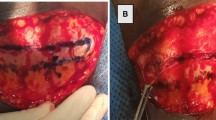Abstract
Introduction and hypothesis
The purpose of this paper is to evaluate the results of sling procedures for stress incontinence after repair of vesicovaginal fistulae at the National Hospital in Niamey, Niger.
Methods
This study is a retrospective chart review of 701 women surgically treated for vesicovaginal fistulae. One hundred forty women subsequently underwent a sling procedure for stress incontinence after fistula repair.
Results
The demographics among the groups were similar. No significant difference was seen in results between the sling types except the risk of erosion was significantly greater in the synthetic sling group. There was a trend towards greater sling success in the fascia lata group.
Conclusions
Correction of incontinence is a common and difficult challenge following repair of obstetric vesicovaginal fistula. Compared to published studies on sling procedures, these patients have higher rates of continued incontinence. This is likely due to the frequent loss of a urethral sphincter as well as high prevalence of detrusor overactivity and decreased bladder capacity.
Similar content being viewed by others
References
Nafiou I, Idrissa A, Ghaichatou AK, Roennenburg ML, Wheeless CR, Genadry RR (2007) Obstetric vesico-vaginal fistulas at National Hospital of Niamey, Niger. Int J Gynaecol Obstet 99:s71–s74
Nardos R, Browning A (2009) Risk factors that predict failure after vaginal repair of obstetric vesicovaginal fistula. Am J Obstet Gynecol 200(1):e1–e4
Rijken Y, Chilopora GC (2007) Urogential and rectovaginal fistulas in southern Malawi: a report on 407 patients. Int J Gynaecol Obstet 99:585–589
Murray C, Goh J, Fynes M, Carey M (2002) Urinary and faecal incontinence following delayed primary repair of obstetric genital fistula. BJOG 109:828–832
Wall LL, Karshima JA, Kirschner C, Arrowsmith SD (1998) The obstetric vesicovaginal fistula: characteristics of 899 patients from Jos, Nigeria. Am J Obstet Gynecol 81:539–542
Raassen TJ, Verdaasdonk EG, Vierhout ME (2008) Prospective results after first-time surgery for obstetric fistulas in East African women. Int Urogynecol J 19:73–79
Waaldijk K (2004) The immediate management of fresh obstetric fistulas. Am J Obstet Gynecol 191:795–799
Carey MP, Goh JT, Fynes MM, Murray CJ (2002) Stress urinary incontinence after delayed primary closure of genitourinary fistula: a technique for surgical management. Am J Obstet Gynecol 156(5):948–1531
Arrowsmith D (1994) Genitourinary reconstruction in obstetric fistulas. J Urol 152:403–406
Hilton P, Ward A (1998) Epidemiological and surgical aspects of urogenital fistulae: a review of 25 years’ experience in southeast Nigeria. Int Urogynecol J Pelvic Floor Dysfunct 9:189–194
Browning A (2004) Prevention of residual urinary incontinence following successful repair of obstetric vesico-vaginal fistula using a fibro-muscular sling. BJOG 111:357–361
Hamlin R, Nicholson E (1969) Reconstruction of the urethra totally destroyed in labour. BMJ 1:147–150
Conflicts of interest
None.
Author information
Authors and Affiliations
Corresponding author
Additional information
This study was conducted in Niamey, Niger through the International Organization for Women and Development
Rights and permissions
About this article
Cite this article
Ascher-Walsh, C.J., Capes, T.L., Lo, Y. et al. Sling procedures after repair of obstetric vesicovaginal fistula in Niamey, Niger. Int Urogynecol J 21, 1385–1390 (2010). https://doi.org/10.1007/s00192-010-1202-5
Received:
Accepted:
Published:
Issue Date:
DOI: https://doi.org/10.1007/s00192-010-1202-5



